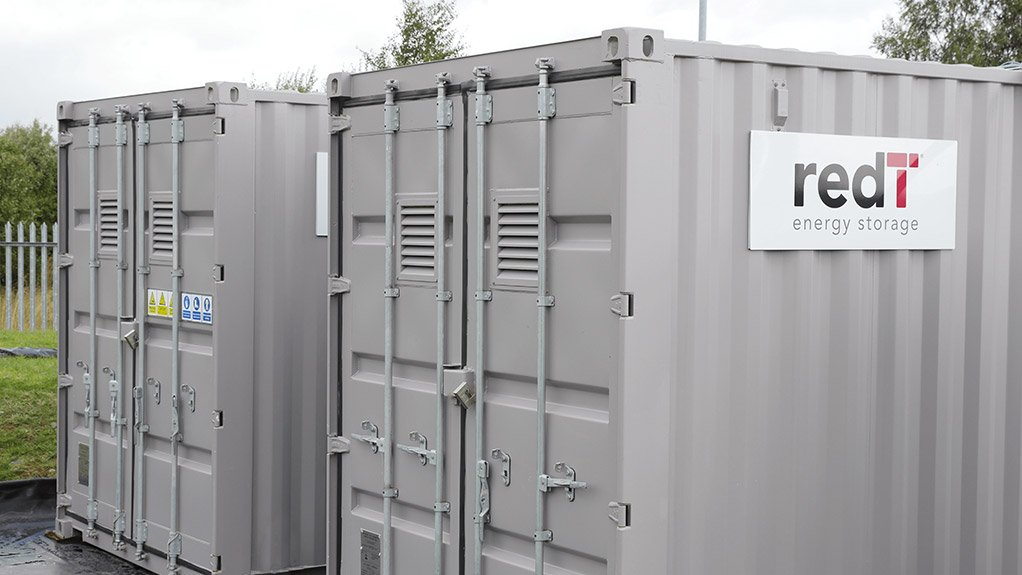Containerised liquid-energy storage machines, or flow machines, coupled with solar photovoltaic (PV) power generation, could provide Africa with the most cost- effective and energy efficient off-grid electricity generation solution, says UK-based energy storage solutions company redT CEO Scott McGregor.
Speaking on the sidelines of the Electricity & Power World Africa conference, which took place earlier this month in Sandton, McGregor highlighted that one of the greatest benefits of flow machines were their ability to store energy, which would discharge for more than 12 hours and “into the day’s range”.
This represents a significant advantage over other conventional energy storage technologies, such as lithium-ion batteries, which are currently restricted to discharge periods of about four hours.
Further, McGregor pointed out that redT’s flow machines could discharge 100% of the energy stored by a solar PV system, while lead-acid batteries and lithium-ion batteries discharge about 30% and 50% of the stored energy respectively.
This is due to the batteries having to limit their depth of discharge to avoid permanent damage to the system, an issue that does not affect redT’s technology.
Flow machines have a higher initial capital outlay relative to that of other energy storage systems, starting at about $500 kW/h. However, he pointed out that, because flow machines have a significantly greater longevity and require little maintenance, the total life cycle cost of the solution was considerably less, particularly when used in conjunction with solar PV power generation.
McGregor explained that a flow machine and solar PV combination could provide a return on investment within five to eight years, particularly when used as a more cost-effective alternative to grid-based electricity during peak demand periods. “However, as an off-grid solution, the flow machine solar PV combination has a payback period of three to five years.”
He noted that both solutions had unique benefits, which made them better suited to different applications. The large footprint and higher capital expense of flow machines make them well-matched for heavy-duty applications, such as providing power for a remote mining site, although battery technology installations are more practical in domestic applications, owing to their compact size and cheaper price tag.
How it Works
McGregor explained that redT’s flow machines employed a proprietary vanadium redox flow technology that stores energy by pumping an electrolysing liquid through a permeable ion-exchange membrane, causing an electrochemical reaction.
The electrolysing liquid comprises water, and vanadium salt that is dissolved in a weak sulphuric acid solution. The liquid does not degrade, with a proven life span of more than 30 years.
The company’s flow machines contain a number of 5 kW stacks, depending on the power output requirements of the system. These stacks contain a permeable ion-exchange membrane, which allows the electrochemical redox reaction to take place.
The machines also contain tanks, which hold the electrolysing liquid ands are sized according to the capacity requirements of the application. “The ability to size power and energy requirements independently of each other is a unique benefit of redT’s technology,” McGregor asserted.
Vanadium electrolyte from the positive tank is pumped through the positive side of the stack, and vanadium electrolyte from the negative tank is pumped through the negative side of the stack.
The vanadium ions in the positive half-cell lose an electron, which is then transferred to the vanadium ions in the negative half-cell, thereby causing the reversible chemical reaction known as redox to take place and enabling the system to charge.
When the process is reversed, the system discharges, causing electrical current to flow.
Edited by: Martin Zhuwakinyu
Creamer Media Senior Deputy Editor
EMAIL THIS ARTICLE SAVE THIS ARTICLE
ARTICLE ENQUIRY
To subscribe email subscriptions@creamermedia.co.za or click here
To advertise email advertising@creamermedia.co.za or click here













